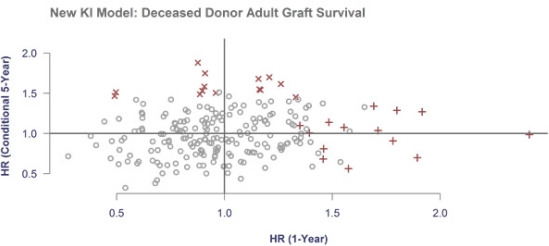Program-Effect Attenuation With Time Posttransplant
1Scientific Registry of Transplant Recipients, Minneapolis Medical Research Foundation, Minneapolis, MN
2Department of Medicine, University of Iowa, College of Medicine, Iowa City, IA
3Department of Medicine, University of Minnesota, Minneapolis, MN.
Meeting: 2015 American Transplant Congress
Abstract number: D241
Keywords: Kidney transplantation, Methodology, Public policy
Session Information
Session Name: Poster Session D: Regulatory Issues in Transplant Administration
Session Type: Poster Session
Date: Tuesday, May 5, 2015
Session Time: 5:30pm-6:30pm
 Presentation Time: 5:30pm-6:30pm
Presentation Time: 5:30pm-6:30pm
Location: Exhibit Hall E
The program-specific reports produced by SRTR include 1-month, 1-year, and 3-year posttransplant graft and patient survival measures. The 1-month and 1-year measures use the same 2.5-year cohort of transplant recipients. The 3-year measures use an older non-overlapping 2.5-year cohort. The 3-year measures have limitations: they are calculated for older cohorts, so their relevance for current program evaluation is suspect. Follow-up beyond 3 years is ignored. Graft failure and patient death events that occurred during the first year posttransplant are included in the 3-year measures, so 3-year measures are not distinct from 1-year measures. Separate 5-year conditional survival models were built for deceased and living donor adult kidney graft and patient survival using the 3-year model cohorts, excluding recipients with first-year events to avoid the limitations of the 3-year models. For each model, a hazard ratio (HR) was calculated for each program as a performance measure. HRs tended to be least well correlated between the 1-year and 5-year models (Table 1). There was weak correlation between 1-year and 5-year estimated program HRs for deceased donor adult graft survival (Fig. 1), and substantial program-level variability in 5-year conditional graft survival. Although how much long-term outcomes are determined by factors controlled by transplant programs is unclear, these results suggest that 5-year conditional survival metrics could be a useful supplement to 1-year survival metrics.
| Deceased Donor | Living Donor | |||
| Adult Kidney Models | Graft | Patient | Graft | Patient |
| 1-Year, 3-Year | 0.24 | 0.20 | -0.03 | 0.00 |
| 3-Year, 5-Year | 0.63 | 0.66 | 0.61 | 0.70 |
| 1-Year, 5-Year | 0.13 | 0.06 | -0.01 | 0.00 |
 Figure 1. Scatterplot of estimated program hazard ratios for 1-year and conditional 5-year deceased donor adult graft survival. "X" symbols, programs with unusually low 5-year conditional graft survival; "+" symbols, programs with unusually low 1-year graft survival.
Figure 1. Scatterplot of estimated program hazard ratios for 1-year and conditional 5-year deceased donor adult graft survival. "X" symbols, programs with unusually low 5-year conditional graft survival; "+" symbols, programs with unusually low 1-year graft survival.
To cite this abstract in AMA style:
Salkowski N, Hunsicker L, Snyder J, Kasiske B. Program-Effect Attenuation With Time Posttransplant [abstract]. Am J Transplant. 2015; 15 (suppl 3). https://atcmeetingabstracts.com/abstract/program-effect-attenuation-with-time-posttransplant/. Accessed January 7, 2026.« Back to 2015 American Transplant Congress
